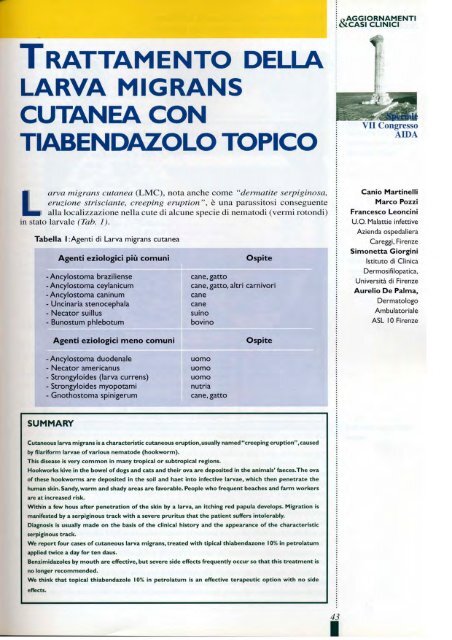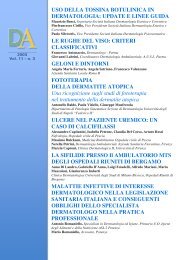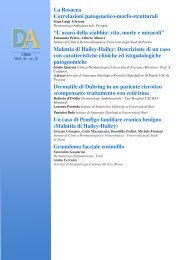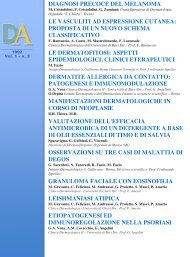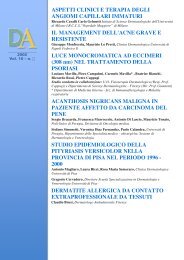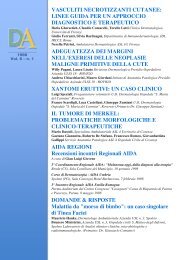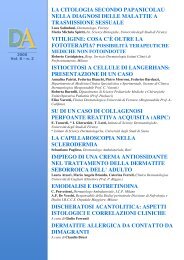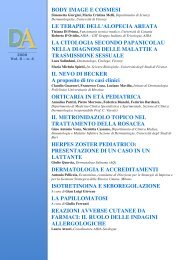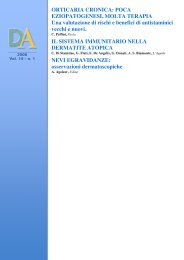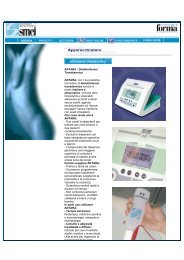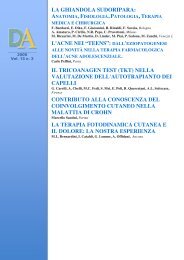Create successful ePaper yourself
Turn your PDF publications into a flip-book with our unique Google optimized e-Paper software.
TRATTAMENTO DELLA<br />
LARVA MIGRANS<br />
CUTANEACON<br />
TIABENDAZOLO TOPICO<br />
arva mig rans cutanea (LMC), nota anche come "dermatite serpig inosa,<br />
eruzione strisciante, creeping eruption ", è una parassi tosi conseguente<br />
alla localizzazione nella cute di alcune specie di ne matodi (vermi rotondi)<br />
in stato larvale (Tab. 1).<br />
Tabella I : Agenti di Larva migrans cutanea<br />
Agenti eziologici più comuni<br />
- Ancylostoma braziliense<br />
- Ancylostoma ceylanicum<br />
- Ancylostoma caninum<br />
- Uncinaria stenocephala<br />
- Necator suillus<br />
- Bunostum phlebotum<br />
Agenti eziologici meno comuni<br />
- Ancylostoma duodenale<br />
- Necator americanus<br />
- Strongyloides (larva currens)<br />
- Strongyloides myopotami<br />
- Gnothostoma spinigerum<br />
SUMMARY<br />
Ospite<br />
cane,gatto<br />
cane, gatto, altri carnivori<br />
cane<br />
cane<br />
suino<br />
bovino<br />
uomo<br />
uomo<br />
uomo<br />
nutria<br />
cane,gatto<br />
Ospite<br />
Cutaneous larva migrans is a characteristic cutaneous eruption, usually named "creeping eruption" ,caused<br />
by filariform larvae of various nematode (hookworm).<br />
This disease is very common in many tropical or subtropical regions.<br />
Hookworks kive in the bowel of dogs and cats and their ova are deposited in the animals' faeces.The ova<br />
of these hookworms are deposited in the soil and haet into infective larvae, which then penetrate the<br />
human skin. Sandy, warm and shady areas are favorable. People who frequent beaches and farm workers<br />
are at increased risk.<br />
Within a few hous after penetration of the skin by a larva, an itching red papula develops. Migration is<br />
manifested by a serpiginous track with a severe pruritus that the patient suffers intolerably.<br />
Diagnosis is usually made on the basis of the clinical history and the appearance of the characteristic<br />
serpiginous track.<br />
We report four cases of cutaneous larva migrans, treated with tipical thiabendazone 10% in petrolatum<br />
applied twice a day for ten daus.<br />
Benzimidazoles by mouth are effective, but severe si de effects frequently occur so that this treatment is<br />
no longer recommended.<br />
We think that topical thiabendazole 10% in petrolatum is an effective terapeutic option with no side<br />
effects.<br />
43<br />
I<br />
o_AGGIORNAMENTI<br />
NCASI CLINICI<br />
VII Congresso<br />
<strong>AIDA</strong><br />
Canio Martinelli<br />
Marco Pozzi<br />
Francesco Leoncini<br />
U.O. Malattie infettive<br />
Azienda ospedaliera<br />
Careggi, Firenze<br />
Simonetta Giorgini<br />
Istituto di Clinica<br />
Dermosifilopatica,<br />
Università di Firenze<br />
Aurelio De Palma,<br />
Dermatologo<br />
Ambulatoriale<br />
ASL IO Firenze


